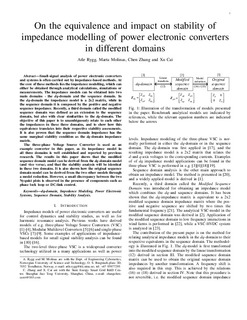| dc.contributor.author | Rygg, Atle | |
| dc.contributor.author | Molinas Cabrera, Maria Marta | |
| dc.contributor.author | Chen, Zhang | |
| dc.contributor.author | Cai, Xu | |
| dc.date.accessioned | 2017-12-14T09:55:09Z | |
| dc.date.available | 2017-12-14T09:55:09Z | |
| dc.date.created | 2017-12-13T11:19:32Z | |
| dc.date.issued | 2017 | |
| dc.identifier.citation | IEEE Journal of Emerging and Selected Topics in Power Electronics. 2017, 5 (4), 1444-1454. | nb_NO |
| dc.identifier.issn | 2168-6777 | |
| dc.identifier.uri | http://hdl.handle.net/11250/2471616 | |
| dc.description.abstract | Small-signal analysis of power electronic converters and systems is often carried out by impedance-based methods. At the core of these methods lies the impedance modeling, which can either be obtained through analytical calculations, simulations, or measurements. The impedance models can be obtained into two main domains: the dq-domain and the sequence domain. In the dq-domain, the impedance model is a 2×2 matrix, while in the sequence domain, it is composed by the positive and negative sequence impedance. Recently, a third domain called the modified sequence domain was defined as an extension to the sequence domain, but also with clear similarities to the dq-domain. The objective of this paper is to unambiguously relate to each other the impedances in these three domains, and to show how this equivalence translates into their respective stability assessments. It is also proven that the sequence domain impedance has the same marginal stability condition as the dq-domain impedance matrix. The three-phase voltage source converter is used as an example converter in this paper, as its impedance model in all three domains is well established and reported by previous research. The results in this paper show that the modified sequence domain model can be derived from the dq-domain model (and vice versa), and that the stability analysis will be identical in these two domains. It is also shown how the original sequence domain model can be derived from the two other models through a model reduction. However, a small discrepancy between the two Nyquist plots is observed in the presence of components such as phase-locked loop or dc-link control. | nb_NO |
| dc.language.iso | eng | nb_NO |
| dc.publisher | Institute of Electrical and Electronics Engineers (IEEE) | nb_NO |
| dc.title | On the Equivalence and Impact on Stability of Impedance Modeling of Power Electronic Converters in Different Domains | nb_NO |
| dc.type | Journal article | nb_NO |
| dc.description.version | submittedVersion | nb_NO |
| dc.source.pagenumber | 1444-1454 | nb_NO |
| dc.source.volume | 5 | nb_NO |
| dc.source.journal | IEEE Journal of Emerging and Selected Topics in Power Electronics | nb_NO |
| dc.source.issue | 4 | nb_NO |
| dc.identifier.doi | 10.1109/JESTPE.2017.2744988 | |
| dc.identifier.cristin | 1526670 | |
| dc.description.localcode | © 2017 IEEE. Personal use of this material is permitted. Permission from IEEE must be obtained for all other uses, in any current or future media, including reprinting/republishing this material for advertising or promotional purposes, creating new collective works, for resale or redistribution to servers or lists, or reuse of any copyrighted component of this work in other works. | nb_NO |
| cristin.unitcode | 194,63,25,0 | |
| cristin.unitname | Institutt for teknisk kybernetikk | |
| cristin.ispublished | true | |
| cristin.fulltext | preprint | |
| cristin.qualitycode | 1 | |
